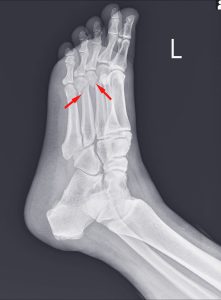How might an ankle injury compensation calculator help you know what you’re owed? Can an online calculator accurately work out what level of damages you are actually entitled to? This guide aims to explain how compensation is calculated after an ankle injury in the workplace, in public or during a road traffic accident caused by others.
We begin by looking at how to use our compensation calculator and how it arrives at an estimate of your settlement. This guide also provides information on the different factors that impact how your compensation could be awarded.
Additionally, we provide details on the eligibility to launch an ankle injury claim. Furthermore, we explore different real-world scenarios in which you could sustain ankle injuries.
Toward the end of this guide, we examine the claims process and look at how long you have to start one. We conclude with a look at how a solicitor from our panel can help support your personal injury claim on a No Win No Fee basis.
If you have any questions, or to check your eligibility to launch a claim for your ankle injury, get in touch today. We’re available around the clock:
- Ring us on 0800 408 7826.
- Speak to us by using the chat window below.
- Contact Us online through our form.
Jump To A Section
- Using Our Ankle Injury Compensation Calculator
- Am I Eligible To Claim For My Ankle Injury?
- Common Causes Of Ankle Injury Claims
- Types Of Ankle Injury You Can Claim For
- How To Begin Your Claim
- How Our Panel Of Solicitors Can Help You Claim
- More Information
Using Our Ankle Injury Compensation Calculator
An ankle injury compensation calculator can include an estimate for both the physical and financial harm you suffered. General damages are the compensation for the physical injury as well as any emotional pain and suffering caused by the accident; whereas special damages compensates for the financial losses caused by your injuries.
A general damages amount could be valued using publications like the Judicial College Guidelines (JCG). These guidelines provide potential compensation figures in brackets for various injuries.
An excerpt from the JCG is shown below. Please note – the first entry is not from the JCG and these amounts are used purely as a guideline way to evaluate physical pain and psychological harm:
Compensation Guidelines
| AREA OF HARM | SEVERITY | COMPENSATION GUIDELINES | NOTES |
|---|---|---|---|
| Cases of multiple serious injury and special damages | Serious | Up to £500,000 plus | Alongside an amount for the ankle injuries and other forms of harm, special damages are included for care provision, medical bills and lost earnings. |
| Foot | (b) Amputation of one foot | £102,470 up to £133,810 | Award reflects the loss of the useful ankle joint. |
| Ankle | (a) Very Severe | £61,090 up to £85,070 | Unusual cases of transmalleolar fracture and soft tissue damage that is extensive. |
| (b) Severe | £38,210 up to £61,090 | Injuries that demand extensive periods of treatment involving a period in plaster and/or with surgical pin inserted into the ankle. | |
| (c) Moderate | £16,770 up to £32,450 | Ligament tears and fractures that create less severe issues with standing for long periods, difficulty on uneven ground or when climbing stairs. | |
| (d) Modest injuries | Up to £16,770 | Lesser sprains and undisplaced fractures where the award amount is determined by whether the person recovered completely or where scarring or instability remains. | |
| Achilles Tendon | (a) Most serious | In the region of £46,900 | Where the tendon is completely severed from the peroneus longus muscle. |
| (b) Serious | £30,500 up to £36,720 | Where despite the repair of a complete tendon division, weakness remains. | |
| (c) Moderate | £15,370 up to £25,710 | Cases of partial rupture and significant tendon damage causing pain or reduced mobility. | |
| (d) Minor | £8,870 up to £15,370 | A turned ankle resulting in some tendon damage and weakness. |
As stated, these are guidelines only. It’s advisable to discuss the merits of your ankle injury claim our team if you would like a more accurate valuation based on your circumstances.
Special Damages – What You Need To Know
In addition to general damages, you may also be eligible to claim for the financial consequences of your ankle injury. This amount comes under special damages and will always require documented evidence to prove any out-of-pocket losses or expenses. With that in mind, you could use:
- Statements and wage slips that prove you suffered loss of earnings after the injury.
- Proof of any private medical expenses.
- Receipts and invoices for the cost of domestic care that others provided.
- Tickets and receipts for vital travel expenses.
- Proof of any prescription charges for painkillers.
If your ankle injury compensation claim is eligible and you wish to use the services of a solicitor from our panel, they can provide expert advice and guidance about evidence. Helping you to build the strongest possible case for ankle injury compensation. One that covers your financial loss now and what might be predicted in the future. Ring us to get started.
Average Payouts For An Ankle Injury
The average compensation that could be awarded for an ankle injury could consider both the injury and financial losses connected to it. As each personal injury claim is decided on its individual merits, providing an average figure won’t offer much insight into what your settlement could be.
For this reason, we urge you instead to consult with our advisors to get a more accurate idea of the ankle injury compensation you could be owed.
Am I Eligible To Claim For My Ankle Injury?
By law, a duty of care is owed to you by certain third parties. Should this duty of care be breached, you might be eligible to seek compensatory damages from those at fault. However, you will need to satisfy three main criteria to move forward with a personal injury claim for ankle damage. You need to show:
- A duty of care was owed to you by the third party.
- They failed to meet this duty.
- You suffered an ankle injury as a consequence.
To clarify your grounds for seeking compensation, why not check your claim status with our advisory team? An advisor can also discuss the estimate you received from our ankle injury compensation calculator.
Common Causes Of Ankle Injury Claims
The following sections look at a few day-to-day scenarios in which you could be eligible to claim ankle injury compensation:
Accident At Work
In the workplace, the safety and well-being of employees are protected by the Health and Safety at Work etc Act 1974 (HASAWA). This legislation outlines the need for employers to take reasonable and practicable actions to protect staff while they work.
Example – An employer provides faulty equipment to staff and it collapses, causing a worker to suffer a shattered ankle in a scaffolding accident. As part of fulfilling their duty of care, the employer is required to carry out inspections of any equipment that is used.
Public Liability
In public places, those in charge of the area are bound by the Occupiers Liability Act 1957 to demonstrate a duty of care. They must implement whatever reasonable steps are necessary to prevent the public from experiencing harm whilst lawfully using their facilities.
Example – The owner of a supermarket fails to promptly attend to a spillage or place warning signs for customers. As a result, a shopper suffers a slip, trip or fall and twists their ankle.
Road Traffic Accidents
All road users must demonstrate care and diligence while on the roads and to comply fully with their duty of care, they need to adhere to the Road Traffic Act 1988 and the Highway Code.
Example – A driver was looking at their mobile phone instead of the road ahead. They collided with a pedestrian in a road traffic accident, causing the pedestrian ankle damage as part of multiple injuries.
The exact scenario of an ankle injury can vary greatly. This is why it’s more beneficial to speak to an expert about your claim rather than rely solely on an ankle injury compensation calculator offered online. There’s no obligation attached when you consult with our team. Why not give it a try?
Types Of Ankle Injury You Can Claim For
You can claim compensation for a minor injury and more severe ankle injuries. If they were caused by negligence, the principal of claiming remains the same no matter the severity.
Broken Ankle
According to this resource from the NHS, a broken ankle can vary in severity but normally involves:
- Discolouration and numbness.
- Soreness, severe pain and inability to bear weight.
- The bone being at an odd ankle.
- Tears to ligaments and tendons.
- The bone penetrating the skin (compound fracture).
- Deformity, weakness or defective gait (a limp).
Sprains, Strains, And Other Minor Injuries
More minor injuries to the ankle, such as sprains and strains, can also be estimated using our ankle injury compensation calculator. These types of injuries typically involve:
- Redness and numbness.
- Tingling and throbbing pain.
- Muscular tightness further up the leg (tendonitis).
- Torn ligaments or tendons.
- Inability to place weight fully on the joint.
Importantly, you can also claim for multiple injuries if they arose from the same accident. Often trauma and psychological harm can be part of an accident. So if ankle damage was just part of the overall injury you suffered, speak to our advisors about submitting a more complete claim.
How To Begin Your Claim
The next sections look at the fundamental building blocks of gathering evidence, understanding time limits and reaching out for help from a solicitor:
Gathering Evidence
If you suffer an ankle injury and want to start a compensation claim, you need evidence that proves those responsible failed to meet their duty of care to you. Some examples of potentially useful evidence to do this include:
- Copies of any CCTV footage from the area.
- Contact information for any eyewitnesses. They can approached later on for a supporting statement.
- Photos of your ankle injury, as well as the cause of the accident.
- A copy from any accident book on the premises.
- Copies of medical records from your GP, or the A&E department.
- Also, any findings by a foot specialist you consulted.
Expert guidance on evidence could help too. If you are interested in seeing whether a solicitor from our panel could assist you, please start by speaking to our advisory team for no-obligation guidance.
How Long You Have To Begin Your Claim
A three-year time limit is usually in place for personal injury claims to start. The Limitation Act 1980 states that this begins from the date of the accident in most cases, but can vary for certain groups:
- Minors cannot claim compensation themselves until they turn 18, at which point they have three years to do so from that date.
- People with reduced mental capacity are not subject to a time limit at all in which to claim unless their capacity returns. They then have three years to start a claim from the date of recovery.
Alternatively, both groups could have a claim start immediately if the courts appoint a litigation friend. Normally, this is a family member or concerned relative who can start a personal injury claim on their behalf.
If you’d like more details about time limits and the role of a litigation friend, our advisory team are happy to assist.
How No Win No Fee Claims Work
Not every solicitor offers their services under a No Win No Fee agreement. However, the solicitors on our panel do. They do this by providing eligible claimants with services under a Conditional Fee Agreement (CFA). This type of contract has a host of advantages for the person seeking compensation, namely:
- No upfront solicitor’s fees.
- No solicitors fees as the claim goes ahead.
- In addition to this, no fee applies for completed services performed by the solicitor if the claim fails.
- Only a legally restricted percentage becomes owed to the solicitors should the claim succeed. This ‘success fee’ is deducted from the compensation at the end.
- A law restricts the success fee amount which allows the claimant to retain virtually all of their compensation.
Advisors can assess the merit of your claim immediately and take it from there. So why not take this opportunity to see if you could improve on what an ankle injury compensation calculator came up with? Call today.
How Our Panel Of Solicitors Can Help You Claim
The solicitors on our panel offer numerous excellent services to the clients they represent. Here are just a few of them:
- They will collect witness statements that support your claim.
- They know how to calculate compensation much more precisely than online compensation calculators.
- Our panel of solicitors attend to the Pre-action Protocol required in personal injury claims.
- They meet essential court deadlines.
- They explain any jargon along the way.
With benefits like this, it makes sense to see if the solicitors on our panel could help you:
- Ring us on 0800 408 7826.
- Speak to us about personal injury cases by using the chat window below.
- Contact us online through this form.
More Information
In addition to this resource on using an ankle injury compensation calculator, you may find the following guides helpful:
- Read our fractured and broken bone compensation calculator here.
- Information if you suffered a soft tissue injury.
- Also, advise on using a child injury compensation calculator and how to claim on behalf of a minor.
External help:
- Guidance on when to call 999 provided by the NHS.
- Information on physiotherapy from the NHS here.
- Also, advice on claiming Statutory Sick Pay (SSP) if you can’t work.
Thanks for reading our guide on the merits of an ankle injury compensation calculator. For any more information about how a specialist personal injury solicitor could help you, reach out to the team.






